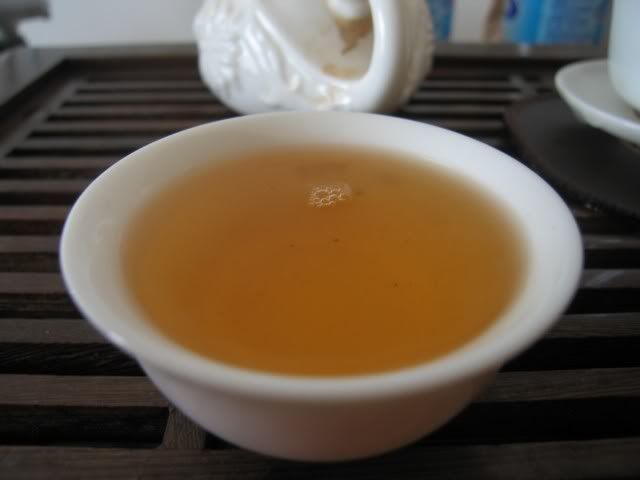This blog was started as a tool for myself, mostly, to record what I’ve tasted and what I thought about them. A depository, of sorts. Gradually more and more people started reading it. Although the readership isn’t exactly large by any stretch of imagination at this point, it does seem like I have readers all over the world, from Australia to the UK. Thanks for reading :).
Today the depository function was used as I revisited the Lao Banzhang from Xizihao, a sample of which I got from Hou De. Gotta give them credit for selling sample sized stuff. It’s nice to be able to taste a lot of different things.
I remember last time when I tasted it I thought it was a bit green-tea like. I also remembered it being a bit bland, actually, not flat, but bland. I also said that the cha qi was quite strong.
I think the same holds true, to a degree, although I think now that I’ve tasted more young puerh, I can say that this is some sort of a big tree tea, with reasonable craftsmanship and decent raw material, although probably not the best of the best. The tingling, cooling sensation was there, although it didn’t exactly extend down the throat. The taste was mild, with an underlying bitterness and a taste profile that seems to be in line with other Banzhang I’ve tasted. The tea seems to have aged a bit since I last tasted it, about 5-6 months ago. It could be just me thinking that, but I think given that I added a little less leaves than last time, it still comes out pretty strong, and I could sort of taste a hint of aged puerh in there, although at this point it is very much just a hint of it. There’s some smokiness early on, and it goes away after infusion 4-5.
Cha qi is still decent, and obvious. There’s a good amount of huigan, and the tea, when drunk, is fairly comforting. I thought maybe I should buy something like this. Or, maybe I should go to that place where BBB and I tasted that one decent Banzhang cake — the asking price was high, but maybe it’s worth getting one or two if the taste seems good.
Hmmm, I got too carried away and forgot to include photos.

Standard infusion… about infusion 3-4, I believe. The colour stayed this way for most of the sitting



Maybe because it’s been sitting in a paper bag for a while, the tea is a bit more broken up than I remembered. I was hoping to find a whole leaf, but couldn’t. The reason for that is because I have read that true Old Banzhang old growth tea has two distinctive features — one is that the tip of the leaf does not point straight, but rather turns sideways (IIRC to the right). So that means that rather than having a straght line that can disect the thing into half along the stem, the leaf is actually asymmetrical. The other thing is that the edge of the leaf should be wavy, not flat. There’s a ripple that is only present in Old Banzhang leaves that aren’t there anywhere else. Since I couldn’t find a good sample of leaf for this, however, I couldn’t prove it either way.

 RSS - Posts
RSS - Posts
1 response so far ↓
Meili_snow // November 3, 2006 at 6:10 am |
Though you just mean to entertain yourself, you have shed great light on me in term of Puer drinking and appreciation, especially in a foreign language. Thanks a lot for that.
Your understanding and appreciation of the tea amaze me a lot…All i want to say is that, you are really fantastic..